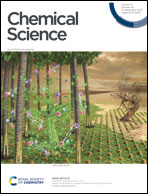Targeted regulation and optimization of multifunctional phase transition materials by novel void occupancy engineering†
Abstract
As an innovative form of stimulus-response materials, organic–inorganic hybrid phase transition materials have become a wonderful contender in the field of functional electronic equipment due to their versatile structure, intensive functions and straightforward preparation. However, the targeted regulation and optimization of the electrical/optical response, along with the establishment of regular structure–performance relationships, pose significant challenges in meeting the diverse demands of practical applications over an extended period. Herein, we conducted a systematic investigation into the role of lattice void occupancy in regulating phase transition temperature (Tp) and related optical/electrical bistability. By taking hybrid material [TMEA][Cd(SCN)3] featuring a flexible ammonium cation [TMEA]+ (TMEA = ethyltrimethylammonium) as the prototype, we successfully synthesized three phase transition materials, namely [DEDMA][Cd(SCN)3], [TEMA][Cd(SCN)3] and [TEA][Cd(SCN)3] (DEDMA = diethyldimethylammonium, TEMA = triethylmethylammonium, and TEA = tetraethylammonium), and the excellent regulation of the physical properties of these compounds was achieved through subtle engineering of void occupancy. More strikingly, [TEA][Cd(SCN)3] exhibits remarkable bistable properties in terms of dielectric and nonlinear optical responses (with second-harmonic generation intensity reaching 2.5 times that of KDP). This work provides a feasible avenue to reasonably customise organic–inorganic hybrid phase transition materials and finely adjust their intriguing functionalities.



 Please wait while we load your content...
Please wait while we load your content...